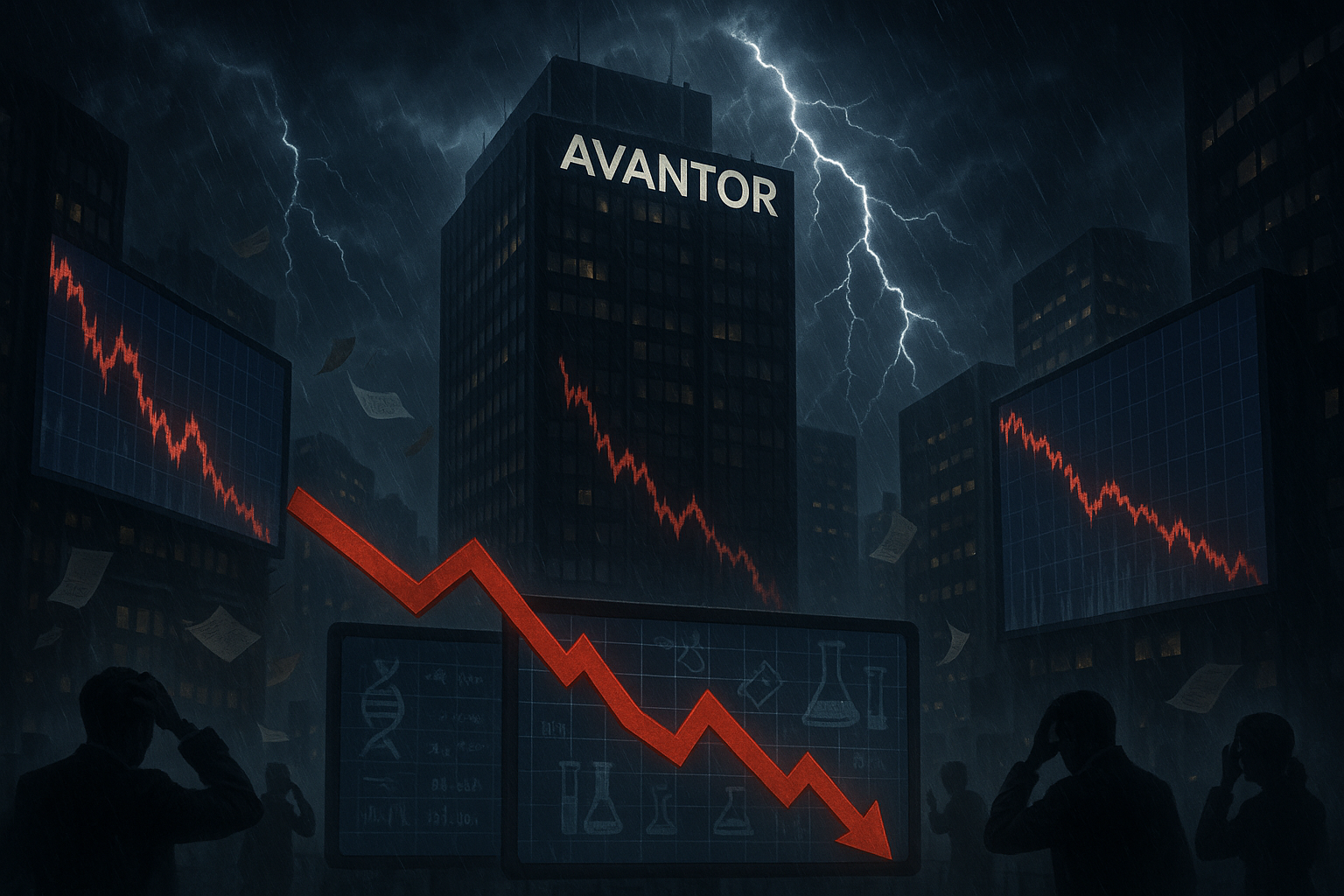
Avantor (NYSE: AVTR) shares have recently experienced a significant and sustained plunge, hitting a 52-week low and reflecting a challenging period for the life sciences company. This sharp decline is a direct consequence of both a widespread market sell-off and a confluence of company-specific issues, sending ripples of concern through the financial markets. The immediate implication for investors is a substantial loss in stock value, with Avantor's shares sinking as much as 16% on one occasion and experiencing further drops following disappointing earnings reports, culminating in a 47.5% decline over the past year. This dramatic downturn has intensified investor scrutiny, prompting a re-evaluation of the company's strategic direction and its ability to navigate a turbulent economic landscape.
What Happened and Why It Matters
Avantor's recent stock performance has been nothing short of alarming for its shareholders. The company's shares have been in a freefall, driven by a perfect storm of macroeconomic pressures and internal operational challenges. Specifically, Avantor reported weaker-than-expected net sales and missed adjusted earnings per share (EPS) estimates in both the first and second quarters of 2025. First-quarter net sales slid 6% year-over-year, and second-quarter revenue remained flat on an organic basis, with net income declining. Compounding these financial woes, the company slashed its full-year guidance for revenue growth and adjusted EBITDA margins, signaling a more pessimistic outlook for the remainder of the year.
The timeline of events leading to this moment highlights a deteriorating situation. Beyond the disappointing financial results, the announcement of CEO Michael Stubblefield's resignation, effective August 18, 2025, after 11 years at the helm, added a layer of uncertainty for investors. This leadership transition comes at a critical juncture, as the company grapples with reduced demand, particularly from the Education and Government end markets due to recent policy changes and funding cuts in U.S. higher education and government sectors. These sectors, accounting for approximately 5% of Avantor's total revenues, have seen reduced capital spending and lower lab activity, directly impacting the company's Laboratory Solutions division. Furthermore, a significant drop in funding for bench-stage biotech companies has weakened demand from this crucial customer segment. Increased competitive intensity has also led to volume losses as customers shift spending to alternative suppliers. In an effort to strengthen its balance sheet and refocus on its core lab and production businesses, Avantor divested its clinical services business for approximately $650 million, a move expected to result in a revenue headwind. All these factors, combined with ongoing margin pressure and broader supply chain issues, have contributed to Avantor's significant downturn.
The broader market sell-off has exacerbated Avantor's woes. This widespread market correction has been attributed to a confluence of factors, including weak economic indicators such as slowing GDP growth, rising unemployment rates, and disappointing jobs reports. Fears of the Federal Reserve maintaining or even raising interest rates, or a reluctance to cut rates, have triggered a "risk-off" sentiment among investors. Geopolitical tensions, including escalating conflicts and trade disputes, have further contributed to market instability. Disappointing earnings reports from key companies, particularly in the tech sector, have accelerated selling pressure, with some economists suggesting that tech stocks were overvalued due to the artificial intelligence craze. Technical factors, such as forced selling by hedge funds and reversals in carry trades, have also played a role in amplifying market moves. While consumer spending has been strong, there are indications that consumers, especially lower-income households, are becoming more cautious due to high prices. Avantor, as a company operating within the broader economic ecosystem, is inevitably caught in the crosscurrents of these larger market forces, making its recovery even more challenging.
Winners and Losers in the Wake of Avantor's Decline
The significant plunge in Avantor's (NYSE: AVTR) share price, coupled with the broader market sell-off, creates a distinct landscape of winners and losers within the life sciences and technology industries. For Avantor shareholders, the impact has been unequivocally negative, with substantial losses in stock value. While some analysts suggest the stock may be undervalued at its current P/E ratio of 12.94, the immediate financial performance has been a severe blow to investor confidence. The company itself is a clear loser in the short term, facing intense scrutiny and the need for strategic re-evaluation under new leadership. Its announced new operating model, focusing on Laboratory Solutions and Bioscience Production, along with a target of $300 million in cost savings by the end of 2026, indicates a period of internal restructuring and potentially slower growth as it consolidates.
On the other side of the coin, Avantor's major competitors stand to gain. Companies such as Thermo Fisher Scientific (NYSE: TMO), Danaher (NYSE: DHR), Agilent Technologies (NYSE: A), and Revvity (NYSE: RVTY) are well-positioned to capitalize on Avantor's instability. If customers perceive Avantor's current challenges as a risk, they may shift their business to these more stable and diversified players. These competitors could intensify their sales and marketing efforts to attract Avantor's customer base, potentially leading to increased revenue and improved financial performance. Furthermore, larger, financially strong life sciences companies, including private equity firms, may view Avantor's depressed valuation as an attractive acquisition opportunity. The life sciences sector has seen a significant trend towards mergers and acquisitions (M&A), driven by the need for portfolio expansion, addressing patent expirations, and accelerating market entry for new therapies. A downturn in a company like Avantor could present an opportune time for strategic acquisitions to enhance market position, expand product portfolios, or gain access to new technologies, ultimately leading to long-term growth and increased profitability for the acquiring entities.
Smaller, less diversified life sciences suppliers, however, are likely to be among the losers. A market sell-off often leads to increased caution among investors and a flight to quality, making it harder for smaller companies with less robust financial health or narrower product portfolios to secure funding or maintain market share. Reduced investor confidence and tighter capital markets can negatively impact their valuations and ability to raise capital for research and development or expansion. These companies might face increased pressure to consolidate or be acquired by larger players seeking to expand their portfolios or achieve economies of scale. Conversely, companies that can offer comprehensive solutions or specialize in high-demand areas, such as biologics production or advanced materials, may find themselves in a stronger negotiating position, either for organic growth or as attractive acquisition targets, benefiting from the ongoing industry consolidation.
Industry Impact and Broader Implications
Avantor's share plunge and the broader market sell-off are not isolated incidents but rather symptomatic of wider trends impacting the life sciences industry and the global economy. This event fits into a narrative of increasing economic uncertainty, where even traditionally resilient sectors like pharmaceuticals and life sciences are experiencing volatility. The industry has been grappling with higher interest rates, which increase the cost of capital for research and development and expansion, and broader economic uncertainties that can lead to reduced spending from key customer segments. Geopolitical factors, including ongoing conflicts and trade disputes, further contribute to a cautious investment environment.
The potential ripple effects on competitors and partners are significant. While larger competitors may gain market share in the short term, a prolonged downturn in a major player like Avantor could signal deeper systemic issues within the biochemical supply chain, potentially impacting pricing power and overall industry growth. Partners, particularly smaller biotech firms reliant on Avantor's products and services, might face supply chain disruptions or increased costs, affecting their own operational efficiency and time-to-market for new therapies. Regulatory or policy implications could also emerge if the market downturn prompts governments to re-evaluate funding for research and development or introduce new incentives to stabilize the sector.
Historically, periods of market volatility and economic slowdown have often led to increased consolidation within the life sciences industry. Companies with strong balance sheets tend to acquire smaller, distressed assets to expand their portfolios and achieve economies of scale. This trend is already evident in the life sciences sector, driven by the need for portfolio diversification, addressing patent expirations, and accelerating market entry for new therapies. The current environment could accelerate this consolidation, leading to a more concentrated industry landscape. Comparisons to past economic downturns suggest that while the immediate impact can be severe, the life sciences industry has historically demonstrated resilience due to the ongoing demand for innovative therapies, particularly in areas like oncology and immunology, and the shift towards biologic drug production. However, the current confluence of factors, including persistent inflation, high interest rates, and geopolitical instability, presents a unique set of challenges that may test the industry's adaptability.
What Comes Next
The path forward for Avantor (NYSE: AVTR) and the broader life sciences market is characterized by both significant challenges and transformative opportunities. In the short term, Avantor's immediate focus will be on stabilizing its financial performance and regaining investor confidence. The company's ongoing cost transformation initiative, aiming for $400 million in savings by the end of 2027, is crucial for margin expansion in 2025. A key strategic pivot will involve rebalancing its portfolio, leveraging the resilience and strong margins of its Bioscience Production segment, which caters to biopharma and medical research. While the Laboratory Solutions segment faces headwinds from funding cuts in academia and government, Avantor must adapt to these changing landscapes and differentiate its offerings to address sustained pressure in this area, which still accounts for a substantial portion of its revenue. The smooth transition of leadership following the CEO's departure will also be critical in maintaining strategic direction and investor trust.
In the long term, Avantor's success will hinge on its ability to embrace the broader trends shaping the life sciences industry. This includes a deeper investment in innovation, particularly through early engagement with customers in their product development cycles, especially in emerging areas like cell and gene therapy. The company's expansion of its Bridgewater, N.J. innovation center underscores this commitment to fostering collaboration with biotech and biopharma customers. Furthermore, optimizing supply chains will be paramount, as the industry emphasizes securing and streamlining operations, a lesson learned from recent global disruptions.
For the broader life sciences market, the future is defined by rapid growth and significant transformation driven by digital advancements and scientific innovations. The increasing integration of artificial intelligence (AI) is a major opportunity, with AI investments in biopharma projected to generate substantial value relative to revenue, accelerating drug discovery, predicting drug efficacy, and optimizing clinical trials. Personalized medicine and genomics are also experiencing rapid growth, driven by technological advancements and increasing demand for targeted therapies, with the personalized medicine market projected to reach over $1.1 trillion by 2033. The biopharmaceutical market itself is experiencing robust growth, fueled by new drug discoveries and cutting-edge medical devices, particularly in vaccine technology, monoclonal antibodies, and gene therapies. Contract Research Organizations (CROs) are also poised for continued growth due to increased outsourcing of clinical trials and rising R&D investments. The industry is also bracing for increased M&A activity, driven by the "patent cliff" and the need for companies to fill pipeline gaps and optimize portfolios. While challenges such as business volatility, talent shortages, regulatory scrutiny, and drug pricing pressures persist, the underlying demand for innovative therapies and the transformative power of new technologies present significant opportunities for companies that can adapt and innovate.
Conclusion
Avantor's recent share plunge serves as a stark reminder of the interconnectedness of company-specific challenges and broader market dynamics. The confluence of disappointing financial results, a leadership transition, and macroeconomic headwinds has created a difficult period for the company and its investors. However, this event also highlights the inherent resilience and ongoing strategic importance of the life sciences industry. While Avantor faces the immediate task of cost optimization and strategic rebalancing, its long-term success will depend on its ability to navigate the evolving landscape of scientific innovation and digital transformation.
Moving forward, investors should closely watch Avantor's execution of its cost-saving initiatives and its ability to leverage the strength of its Bioscience Production segment. The company's efforts to innovate and engage with customers in emerging therapeutic areas will be crucial for sustainable growth. For the broader market, the key takeaways include the accelerating pace of digital transformation, particularly the integration of AI, and the continued growth of personalized medicine and genomics. These trends present significant opportunities for companies that can effectively harness new technologies and adapt to changing market demands.
Despite the current volatility, the life sciences sector remains a vital and growing industry. The ongoing demand for innovative therapies, coupled with advancements in biotechnology and medical devices, suggests a robust long-term outlook. Investors should monitor M&A activity, as consolidation is likely to accelerate, and keep an eye on venture capital funding and IPO activity as indicators of renewed investor confidence. Ultimately, the companies that can demonstrate agility, strategic foresight, and a commitment to innovation will be best positioned to thrive in this dynamic and ever-evolving market.







